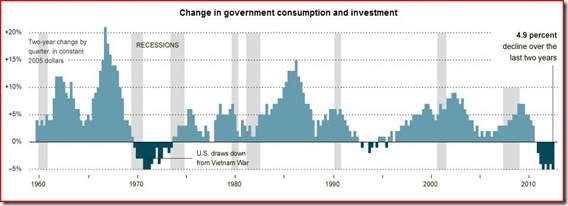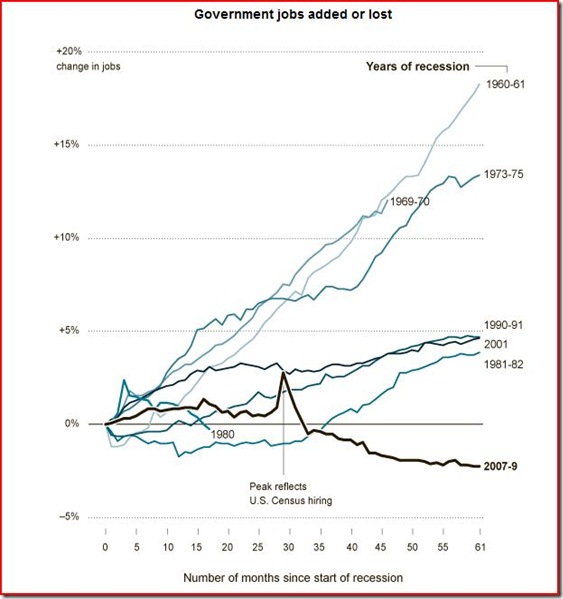Peter pointed out a front page piece in the February 27 issue of The New York Times entitled “Austerity Kills Government Jobs as Cuts to Budgets Loom” that made just about the same points I’d made in Monday’s lecture.
… Those cuts would join an earlier round of deficit reduction measures passed in 2011 and the wind-down of wars in Iraq and Afghanistan that already have reduced the federal government’s contribution to the nation’s gross domestic product by almost 7 percent in the last two years.
The above point is not making any claims about the multiplier, just pointing out that from an accounting perspective, government spending on the stuff that counts (in a Keynesian sense) is down about 7%. In turn, that is about 20% of the U.S. economy, so spending is contributing to about a 2% drop in real GDP (see Section1, Table 1.1.6).
As always, they have an informative chart (copy shown above). Note that the last time the Republicans went through with something like this is shown in 1995 … in large measure, that increase Clinton’s popularity prior to his reelection.
Federal, state and local governments now employ 500,000 fewer workers than they did on the eve of the recession in 2007, the longest and deepest decline in total government employment since the aftermath of World War II.
Here’s a chart of government employment relative to the previous peak of the business cycle (copy shown above).
That amount corresponds to adding about 0.4% to the unemployment rate. Here they make the same point I’ve made a few times in class (they just don’t have the guts to call it the Obama bait-and-switch like I do ;)
Total government spending continues to increase, but those broader figures include benefit programs like Social Security. Government purchases and investments expand the nation’s economy, just as private sector transactions do, while benefit programs move money from one group of people to another without directly expanding economic activity.
…
… sequestration mostly spares Medicare and Medicaid, the health care programs that are the primary reason federal spending is projected to increase.
Then they quote Tyler Cowen (a professor from George Mason University, who blogs at Marginal Revolution, and writes a column for The New York Times):
“People focus on the upfront cost and they don’t think through the whole timeline,” said Tyler Cowen, an economist at George Mason University and an occasional contributor to the Sunday Business section of The New York Times. “You have to cut spending within the next 10 years anyway. It may be time to take some lumps.”
I find nothing wrong with that view. I think sequestration is dumb along many dimensions and useless along others … but I have no trouble with beginning to end the charade that government does much other than write checks.


No comments:
Post a Comment